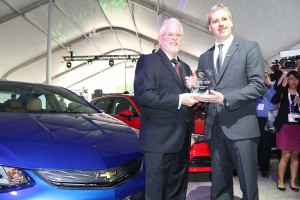Remember the 1990s when we had GM’s EV1 and a few other fringe green vehicles? Of course, automakers began figuring out many of the mysteries of battery electric vehicles as well as other ways to make new vehicles more environmentally friendly and the proliferation began.
If you’re going to have more than one “green” vehicle that means someone’s vehicle’s got to be the best, right? And that means an award: the Green Car of the Year.
Remember the 2000s when we had the Green Car of the Year award from the Green Car Journal? Well, like the vehicles themselves, the awards have grown with the offerings – the first was the Mercury Mariner in 2006 – and at last week’s Washington, D.C. auto show, the online magazine named its winners in five categories.
“These are stand-out vehicles in an increasingly sophisticated and appealing field of ‘green’ cars. To make the cut as a finalist is a real achievement in itself considering the considerable competition in the market today,” said Ron Cogan, editor and publisher of Green Car Journal and Cars of Change.
“Rising to the top as award winners means these three exceptional vehicles set a benchmark in the auto industry’s effort to create vehicles that are desirable and efficient, while also achieving environmental milestones so important for our driving future.”
(Mazda captures most-efficient brand title again. For more, Click Here.)
This year’s Green Car of the Year was the Chevy Volt. The plug-in beat out the Audi A3 e-tron, the fourth-generation Toyota Prius, the Hyundai Sonata and Honda Civic. The award now carries quite a bit weight with automakers and consumers: companies include the honor in their promotion of winning vehicles.
“Chevrolet is all about bringing affordable electrification to our customers, and that is exactly what we did with the Volt” said Steve Majoros, Chevrolet marketing director. “For Volt to stand out in Green Car’s evaluation, it reaffirms Chevrolet’s commitment to being a leader in electrification.”
The awards handed out last week include:
- Luxury Car: Volvo XC90 T8
- Green SUV: Honda HR-V
- Connected Car: Chevy Malibu
The Green Truck of the Year is the Ford F-150 pickup, which was handed out late last year at the San Antonio Auto & Truck Show. While the truck’s new EcoBoost-powered option was a primary driver of the award, it’s also available in a compressed natural gas option, Cogan noted.
(Click Here for details about the rising sales of plug-in electric vehicles.)
However, it’s not just the powertrain or mileage rating that got the F-150 the award, he noted: Ford uses sustainable materials to help reduce its environmental footprint.
The maker uses Repreve fiber, which is made from recycled plastic bottles, for the F-150’s cloth seats. It diverted more than 5 million plastic bottles from landfills by using the new material.
(To see more about Honda’s new hydrogen-powered Clarity, Click Here.)
Other eco-conscious materials employed include rice hulls to reinforce plastic used in an electrical harness, fuel lines made from castor bean oil, seats made of soybeans and post-industrial recycled cotton – one 2015 F-150 uses shoddy that includes blue jean material, bath towels and/or T-shirt material.


Go, Ron! It was a good idea back then. It’s a good one now.
EVs are so practical that the EPA had to hold a gun to car makers heads to get them to make EVs. EV’s were not practical a 100 years ago and they are still impractical. That’s why hydrogen fuel cells will replace battery EVs. The very few who feel the need for an EV or who believe they are saving the planet… will at least be able to do reasonable driving in all weather conditions and not have to worry about being stranded on the roadway like with a battery powered EV.
Just think how desperate an EV owner would have been if caught out on the roads in the latest snow storm, Jonas. The battery would be dead real fast driving in 10+ inches of snow with the heater and wipers running full speed just to try and see the road. That mythical 300 mile range would have turned into less than a 100 miles real fast.